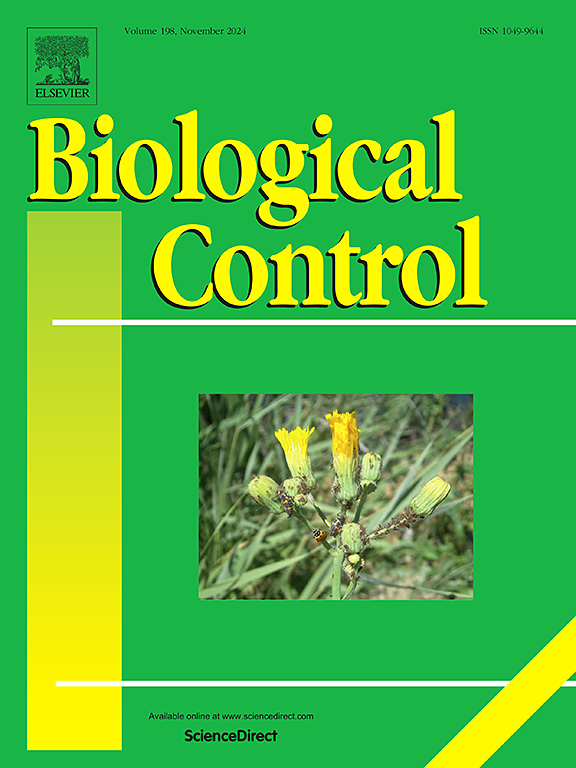内生真菌Epichloë sibirica的比较基因组和转录组分析揭示了寄主西伯利亚Achnatherum sibiricum的生物控制机制
IF 3.4
2区 农林科学
Q2 BIOTECHNOLOGY & APPLIED MICROBIOLOGY
引用次数: 0
摘要
Epichloë属的内生真菌可以增强宿主对植物病原体的免疫防御。然而,内生菌调节宿主反应的潜在机制仍然知之甚少。本研究通过比较基因组学和转录组学的方法阐明了Epichloë sibirica保护西伯利亚Achnatherum sibiricum的三方策略。首先,基因组学和转录组学分析表明西伯利亚大肠杆菌能够合成抗生素(如ε-聚l -赖氨酸)和菌丝降解酶。其次,生态位占据得到了以下因素的支持:(1)西伯利亚大肠杆菌在病原体攻击过程中转录组变化极小;(2)在真菌发酵试验中具有较强的抑菌活性(西伯利亚大肠杆菌对4种病原体具有较强的抑菌活性,而病原体衍生的菌液对西伯利亚大肠杆菌生长的影响可以忽略不计);(3)比较抗生素敏感性试验表明,西伯利亚大肠杆菌对strobilurin A、四环素、硫酸链霉素和青霉素钠与病原体的比较。第三,宿主抗性诱导涉及编码效应蛋白、细胞壁修饰酶和海藻糖的基因簇。这些发现表明西伯利亚大肠杆菌通过代谢物介导的拮抗作用、生态位占领和宿主启动,具有多方面的生物防治作用。我们的研究结果为内生菌驱动的三方防御机制提供了组学水平的证据。本文章由计算机程序翻译,如有差异,请以英文原文为准。
Comparative genome and transcriptome analysis of the endophytic fungus Epichloë sibirica reveals biological control mechanism in host Achnatherum sibiricum
Endophytic fungi of the genus Epichloë can bolster the host’s immune defenses against phytopathogens. However, the underlying mechanisms by which the endophytes regulate host responses remain poorly understood. This study elucidates the tripartite strategy employed by Epichloë sibirica to protect Achnatherum sibiricum through comparative genomics and transcriptomics. First, genomic and transcriptomic analyses revealed that E. sibirica can synthesize antibiotics (e.g., ε-poly-L-lysine) and mycelial degrading enzymes. Second, ecological niche occupation was supported by (1) minimal transcriptomic alterations in E. sibirica during pathogen challenge, (2) superior antimicrobial activity in fungal fermentation assays (superior antimicrobial activity of E. sibirica against four pathogens, while pathogen-derived broths had negligible effects on E. sibirica growth), and (3) comparative antibiotic susceptibility testing demonstrated E. sibirica’s significantly higher tolerance to strobilurin A, tetracycline, streptomycin sulphate, and penicillin sodium compared to pathogens. Third, host resistance induction involved gene clusters encoding effector proteins, cell wall-modifying enzymes, and trehalose. These findings identify E. sibirica as a multifaceted biocontrol agent through metabolite-mediated antagonism, ecological niche occupation, and host priming. Our results provide omics-level evidence of endophyte-driven tripartite defense mechanisms.
求助全文
通过发布文献求助,成功后即可免费获取论文全文。
去求助
来源期刊

Biological Control
生物-昆虫学
CiteScore
7.40
自引率
7.10%
发文量
220
审稿时长
63 days
期刊介绍:
Biological control is an environmentally sound and effective means of reducing or mitigating pests and pest effects through the use of natural enemies. The aim of Biological Control is to promote this science and technology through publication of original research articles and reviews of research and theory. The journal devotes a section to reports on biotechnologies dealing with the elucidation and use of genes or gene products for the enhancement of biological control agents.
The journal encompasses biological control of viral, microbial, nematode, insect, mite, weed, and vertebrate pests in agriculture, aquatic, forest, natural resource, stored product, and urban environments. Biological control of arthropod pests of human and domestic animals is also included. Ecological, molecular, and biotechnological approaches to the understanding of biological control are welcome.
 求助内容:
求助内容: 应助结果提醒方式:
应助结果提醒方式:


